
Click image to enlarge
First court house in Johnson County built at Napoleon, 1838
Source: U of IA Digital Collection - sketch from Gilbert R. Irish | With
the increase of settlers came divided opinion as to the location of a
town site which in time would become the county seat. One party favored
a location west of the river and they determined to name their town
Osceola. The other party, under the lead of John Gilbert and Philip
Clark, favored a town east of the river, and they selected upon Indian
land in what is now section twenty-two East Lucas township for a town
site, and obtaining consent of the Indians they built thereon a small
cabin and employed John Morford to live in it and hold the claim for
them when the Indians should sell and vacate the land.
After the
treaty of 1837 the town site became government land and Clark traded
his farm located in 1836 for the Morford claim and proceeded to lay out
a large town, giving it the name of Napoleon. A court house was built,
and on July 4, 1838, Napoleon became the county seat of Johnson County.
Philip
Clark, after the location of the territorial capital at Iowa City,
converted the town of Napoleon into a farm and for many years was one
of the foremost farmers and business men of the county.
|
|
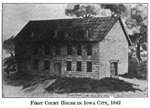
Click image to enlarge
First court house in Iowa City 1842
Source: U of IA Digital Collection | On
April 8, 1842, it was ordered, that F. H. Lee, agent for the county of
Johnson, be instructed and authorized to receive proposals for the
erection of a court house on lot No. 8, in block No. 8, in the county
seat of the county. The house to be of brick, 56x28 ft., two stories,
and to be finished according to the plan of said building in the hands
of said agent. The house must be completed by the first day of October,
A.D., 1843. On June 17, 1842, Mr. Tremble is allowed $500 on his
contract to build the court house. On October 6, 1842, he was again
“allowed the sum of nine hundred dollars on his contract for erecting
the temporary court house”
Prior to the erection of this
building, the county had rented various rooms and buildings, such as
could be obtained, when necessary, for court and jail purposes, and the
use of county officers. |
|
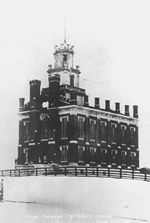
Click image to enlarge
First Johnson County Court House, 1860
Source: U of IA Digital Collection | Feb
20, 1856 “The subject of the erection of a new court house and jail for
the county of Johnson, Iowa, being under consideration; and the county
judge therefore being satisfied that there is a great want of public
buildings of this kind.
Orders, that an election be held
in the county, at the usual place of holding in the several townships
in said county, to take the sense of the people upon the questions,
whether money shall be borrowed for the erection and completion of a
court house and jail, on the block of ground known as the courthouse
square, in that part of Iowa City known as the county seat of Johnson
County; and also, whether that portion of the proceeds of the sales of
swamp lands belonging to the county, shall be applied toward the
payment of the borrowed money; and also whether a tax shall be levied
on the taxable property to pay the interest on the loan.
The vote on the above propositions was taken April 7, 1856.
|
|
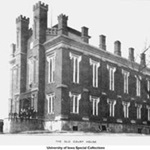
Click image to enlarge
Johnson County Court House, 1900
Source: U of IA Digital Collection | THE COURT HOUSE
The
present court house was opened to public use in 1857. It is said to
have cost about $70,000. Just how it was built we don’t know, but
certain during a generation no taxes have been levied for the payment
or any bonds represented in its building, even if bonds were issued for
the purpose. Since the court house was built and paid for a new
generation has come into possession of Johnson county’s property.
The
expenses caused by the court house in these years have been repairs and
the erection of the clerk and recorder’s offices rendered absolutely
necessary by the growing of the county business beyond the capacity of
the old court house; and these offices, particularly that of the clerk,
are already crowded so that papers are no longer readily accessible or
easily handled. The same conditions are found at the treasurer’s and
auditors’ offices.
| The repairs have been quite heavy it is
true. In the first place the old court house was not too well
built. The walls of the underground jail have been often honeycombed by
escaping prisoners, the floors have fallen into decay and the want of
proper sewerage and drainage made it, after some years of occupancy, at
times pestilential beyond description. It was in its first years heated
by wood stoves, then by coal, and at last furnaces were put in place.
When
the building was erected an immense and unsightly wooden tower was
constructed over the east entrance and the storms and gales of years
swayed the tower until the leverage began to tell on the walls and at
last, to preserve the building, it was necessary to have the tower
removed. The stone of the foundation walls has softened and the mortar
crumbled away, the many ? have cracked endangering further the walls
until buttresses were erected on the south side and the walls held
together by immense iron rods traversing the entire structure.
The
building has at last reached that stage of decay when it no longer
safely bears its own weight. None too well constructed at first, in the
days when it was difficult to secure proper materials at this place for
so large a building, it shows in unpleasant degree the crumbling touch
of time.
But it is inadequate for the purpose for which built. In
1856 Johnson County contained yet much “wild land” the population was
small and the builders may have been excusable in supposing that the
court house of their day would answer for a century. No doubt they held
that opinion. As we have said, the clerk and recorder have already been
crowded out, and the treasurer and auditor have scarce room at hand for
the most
The court room is altogether too small for a county of
25,000 people. It is expected and very properly, that important public
meetings will be held in the court house. Such is and has been the
custom for many years in every state. Johnson county’s court house does
not offer a court house suitable for such purpose. The county
conventions of the political parties have long crowded it to the walls,
and to the point of danger, while at trials attracting public attention
the room has proved far too small for the number desiring to obtain
entrance. important records in daily use. At every term of
court, the records and files must be carried from the detached office
up to the court room and as it is physically almost impossible to carry
them back and forth every day, they remain in the court house during
the term.
There is probably not a taxpayer in the county who does
not agree that Johnson County ought to have a new court house. That the
present structure is inadequate, dangerous and unworthy the dignity of
the county; that it suffers in comparison with the city hall, with the
new University buildings, with the new Rock Island depot and with many
private residences.
This generation has not been taxed for the old
court house. It will lay no such burden of taxation upon its members as
did the present building upon the taxpayers at whose expense it was
built.
The levy provided by the board of supervisors, two mills on
the dollar, will be based on the new assessment which provides for the
taxation of property at one fourth its actual cash value. This levy
will continue for eight years, the last perhaps being only a partial
levy, or it may require eight full years and a portion of the ninth, as
circumstances that can never be foreseen or provided for may require,
such as a change in the rate of valuation by the state, destructive
storms that may lead to exemption by the board.
Keeping in mind that
the assessed valuation of property is to be only one fourth the real
valuation, the following represents the amount of annual tax for the
court house on various sums.
The average forty acres of land in this
county is valued at about $1500 and assessed at $400 and will be taxed
for a court house 80 cents a year. The average house and lot in Iowa
City is worth about the same and will pay the same amount.
Every
property owner every citizen of Johnson County is interested in a new
court house ...(illegible) in every effort that will tend to improve
the value of his property. The new court house must come in a short
time, for the reason that the county cannot get along without it.
Within the past few months, the citizens of Iowa City and Johnson County were asked to make purchas
It
has been suggested that the county provide a temporary court house.
There is no valid reason for so doing. If the court house is to be
built, now is the time to borrow money for that purpose. No
better could be.
One other thing – the county has no jail. It is an
unwarrantable proceeding to hold a well-bred man or woman in the
present jail. It is not secure against the attempt of a desperate
criminal. Tramps may be willing to accept it as a temporary lodging
house, but that is not the purpose of a jail.
The law prescribes the
manner of issuing bonds. The board of supervisors have followed that
manner in submitting the proposition. The questions are now before the
people for their discussion.
THE PRESS cordially supports the
propositions and advises and urges the voters to vote “yes” on each
proposition. (Source: Daily Iowa State Press, Tues., January 31, 1899,
pg. 1) |
|
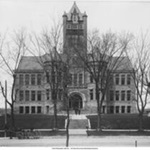
Click image to enlarge
Johnson County Court House, circa 1913
Source: U of IA Digital Collection | COURT HOUSE CUSTODIAN DIES
John Higgins, Sr., Passed Away Last Evening at a Local Hospital After Month’s Illness.
John
Higgins, Sr., the popular and efficient custodian of the Johnson County
court house, passed away at 9 o’clock last night at a local hospital
after an illness of one month.
Mr. Higgins was 65 years of age and
had lived in Iowa City for the past 45 years and was well liked by all
who knew him. He hash been custodian of the court house for many
years. Two sons, John and Thomas, of Chicago, and five sisters survive
him.
The funeral will take place Friday morning from St. Patrick’s
church. The cortege leaving Schneider Bros. undertaking parlors at
8:45. Burial will be in St. Joseph’s cemetery.
The many friends of the departed man, who wish to view the remains, may do so. (Source: Iowa City Daily Press, Iowa City, IA., 29 Dec 1915, Wed., Pg. 1) |
|
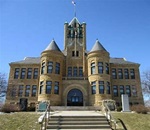
Click image to enlarge
Johnson County Court House, present day
Source: U of IA Digital Collection
| |
|
Court House History & Images by Bob Hibbs |